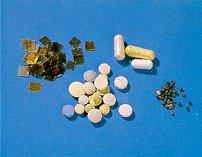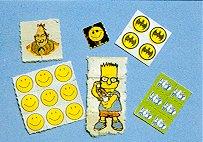



LSD ("acid" ,"trips")
(LSD-25)
(German=Lyserg-Saeure-Diaethylamid)
LSD.. It was first developed in a Swiss laboratory in 1938 - 1940 and explored as a treatment for some mental illnesses. In itís pure state LSD is a white, odorless powder. LSD bought on the street is manufactured illegally and varies in strength. A very small amount is effective, so LSD is usually mixed with a lot of filler to make the dose big enough to take. It comes as liquids, tablets, capsules and squares of gelatin or blotting paper. Other drugs are often sold as LSD.
The effects of LSD begin within half an hour of taking the drug, and are at their strongest in 3 to 5 hours, and can last for up to12 hours.
Effect include seeing things in a distorted way or that donít exist. The person usually knows that what they are seeing is not real. Also, distorted perception of sounds, smells, touch and taste. This is what is commonly called Tripping. Other effects may include:
A number of physical effects, mild to moderate in strength, sometimes occur. They include: numbness, muscle weakness, twitching, dilated pupils, shakiness, poor co-ordination, nausea, vomiting, increased heart beat and blood pressure, increased body temperature and sweating, sometimes alternating with chills and shivering, abnormally rapid deep breathing.
Research has shown some changes in the mental functions of heavy users of LSD, but they are not present in all cases. Heavy users sometimes develop signs of organic brain damage, such as impaired memory and attention span, mental confusion, and difficulty with abstract thinking. These signs may be strong or they may be subtle. It is not yet known whether such mental changes are permanent or if they disappear when LSD use is stopped
While using LSD or "tripping", the person may experience strong feelings of anxiety or fear. The hallucinatory effects can be unpleasant ( e.g. spiders crawling on the skin). Or they can be so intensive that the person feels as if they are loosing control and are "going crazy" while using LSD or "tripping", the person may experience strong feelings of anxiety or fear.
If you are upset, worried about something or in a strange environment you are more likely to experience a bad trip. If this happens to someone you know, take them to quiet surroundings away from bright lights and loud music. Reassure the person that these feelings will gradually wear off and try to keep them calm. Try and stay with them until they are feeling OK.
LSD: acid; LSD-impregnated paper squares: trips, tabs, blotters. (There are hundreds of different printed designs on the paper, and each has its own name. e.g. Superman, Bart Simpson.)
LSD can be absorbed into any suitable substance and therefore can be sold in many forms. Pieces of blotting paper, sugar cubes, microdots and small square flakes of gelatin have all been used. The most popular form today is absorbent sheets of paper. These are divided into squares and impregnated with LSD. The sheets are then printed with a small motif, hence many of the slang terms used. The designs may consist of patterns, symbols, cartoon characters or pictures of current events.
LSD is taken normally taken orally.
Tolerance to LSD develops rapidly but goes away quickly once regular use is stopped. Cross-tolerance can also develop, i.e. using one type of hallucinogen makes you tolerant to other hallucinogens. LSD does not produce any physical dependency. Although most users do not experience any psychological dependence, some feel unable to enjoy their lives without the drug.
There are no physical withdrawal effects from LSD, and most users will not suffer any psychological effects.
Fatal overdose with LSD is not thought to be possible.